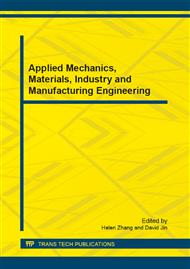p.150
p.154
p.158
p.162
p.166
p.170
p.174
p.178
p.182
Synthesis of a Photochromic Diarylethene Material Bearing Fluorine Atoms for Rewritable Holographic Optical Storage
Abstract:
Photochromism is referred to as a photoinduced reversible transformation reaction between two isomers, open and closed, with different absorption spectra upon irradiation with light of an appropriate wavelength. A new photochromic diarylethene, 1-[2-methyl-5-(3, 5-difluorophenyl)-3-thienyl]-2-(2-methyl-3-benzofuran)perfluorocyclopentene(1o), has ben synthesized. The compound showed good phtochromism both in solution and in solid states. Diarylethene 1o changed the color from colorless to magenta upon irradiation with 313 nm UV light, in which absorption maxima were observed at 523 nm in hexane and at 529 nm in PMMA film, respectively. Especially, the diarylethene exhibited a relatively strong fluorescence switches along with the phtochromism from open-ring isomers to closed-ring isomers in solid states. Using diarylethene 1c/PMMA film as recording medium, optical recording was performed successfully. This new photochromic system also exhibited remarkable optical storage character
Info:
Periodical:
Pages:
166-169
Citation:
Online since:
April 2012
Authors:
Keywords:
Price:
Сopyright:
© 2012 Trans Tech Publications Ltd. All Rights Reserved
Share:
Citation:


